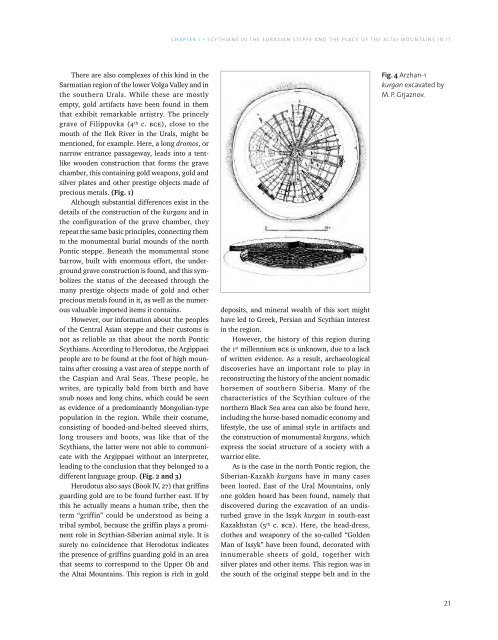Scythian Culture - Preservation of The Frozen Tombs of The Altai Mountains (UNESCO)
You also want an ePaper? Increase the reach of your titles
YUMPU automatically turns print PDFs into web optimized ePapers that Google loves.
CHAPTER I • SCYTHIANS IN THE EURASIAN STEPPE AND THE PLACE OF THE ALTAI MOUNTAINS IN IT<br />
<strong>The</strong>re are also complexes <strong>of</strong> this kind in the<br />
Sarmatian region <strong>of</strong> the lower Volga Valley and in<br />
the southern Urals. While these are mostly<br />
empty, gold artifacts have been found in them<br />
that exhibit remarkable artistry. <strong>The</strong> princely<br />
grave <strong>of</strong> Filippovka (4 th c. bce), close to the<br />
mouth <strong>of</strong> the Ilek River in the Urals, might be<br />
mentioned, for example. Here, a long dromos, or<br />
narrow entrance passageway, leads into a tentlike<br />
wooden construction that forms the grave<br />
chamber, this containing gold weapons, gold and<br />
silver plates and other prestige objects made <strong>of</strong><br />
precious metals. (Fig. 1)<br />
Although substantial differences exist in the<br />
details <strong>of</strong> the construction <strong>of</strong> the kurgans and in<br />
the configuration <strong>of</strong> the grave chamber, they<br />
repeat the same basic principles, connecting them<br />
to the monumental burial mounds <strong>of</strong> the north<br />
Pontic steppe. Beneath the monumental stone<br />
barrow, built with enormous effort, the underground<br />
grave construction is found, and this symbolizes<br />
the status <strong>of</strong> the deceased through the<br />
many prestige objects made <strong>of</strong> gold and other<br />
precious metals found in it, as well as the numerous<br />
valuable imported items it contains.<br />
However, our information about the peoples<br />
<strong>of</strong> the Central Asian steppe and their customs is<br />
not as reliable as that about the north Pontic<br />
<strong>Scythian</strong>s. According to Herodotus, the Argippaei<br />
people are to be found at the foot <strong>of</strong> high mountains<br />
after crossing a vast area <strong>of</strong> steppe north <strong>of</strong><br />
the Caspian and Aral Seas. <strong>The</strong>se people, he<br />
writes, are typically bald from birth and have<br />
snub noses and long chins, which could be seen<br />
as evidence <strong>of</strong> a predominantly Mongolian-type<br />
population in the region. While their costume,<br />
consisting <strong>of</strong> hooded-and-belted sleeved shirts,<br />
long trousers and boots, was like that <strong>of</strong> the<br />
<strong>Scythian</strong>s, the latter were not able to communicate<br />
with the Argippaei without an interpreter,<br />
leading to the conclusion that they belonged to a<br />
different language group. (Fig. 2 and 3)<br />
Herodotus also says (Book IV, 27) that griffins<br />
guarding gold are to be found further east. If by<br />
this he actually means a human tribe, then the<br />
term “griffin” could be understood as being a<br />
tribal symbol, because the griffin plays a prominent<br />
role in <strong>Scythian</strong>-Siberian animal style. It is<br />
surely no coincidence that Herodotus indicates<br />
the presence <strong>of</strong> griffins guarding gold in an area<br />
that seems to correspond to the Upper Ob and<br />
the <strong>Altai</strong> <strong>Mountains</strong>. This region is rich in gold<br />
deposits, and mineral wealth <strong>of</strong> this sort might<br />
have led to Greek, Persian and <strong>Scythian</strong> interest<br />
in the region.<br />
However, the history <strong>of</strong> this region during<br />
the 1 st millennium bce is unknown, due to a lack<br />
<strong>of</strong> written evidence. As a result, archaeological<br />
discoveries have an important role to play in<br />
reconstructing the history <strong>of</strong> the ancient nomadic<br />
horsemen <strong>of</strong> southern Siberia. Many <strong>of</strong> the<br />
characteristics <strong>of</strong> the <strong>Scythian</strong> culture <strong>of</strong> the<br />
northern Black Sea area can also be found here,<br />
including the horse-based nomadic economy and<br />
lifestyle, the use <strong>of</strong> animal style in artifacts and<br />
the construction <strong>of</strong> monumental kurgans, which<br />
express the social structure <strong>of</strong> a society with a<br />
warrior elite.<br />
As is the case in the north Pontic region, the<br />
Siberian-Kazakh kurgans have in many cases<br />
been looted. East <strong>of</strong> the Ural <strong>Mountains</strong>, only<br />
one golden hoard has been found, namely that<br />
discovered during the excavation <strong>of</strong> an undisturbed<br />
grave in the Issyk kurgan in south-east<br />
Kazakhstan (5 th c. bce). Here, the head-dress,<br />
clothes and weaponry <strong>of</strong> the so-called “Golden<br />
Man <strong>of</strong> Issyk” have been found, decorated with<br />
innumerable sheets <strong>of</strong> gold, together with<br />
silver plates and other items. This region was in<br />
the south <strong>of</strong> the original steppe belt and in the<br />
Fig. 4 Arzhan-1<br />
kurgan excavated by<br />
M. P. Grjaznov.<br />
21
















